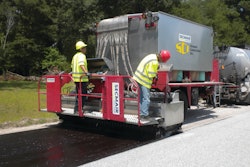
Pavement preservation is an eco-friendly and socially responsible aid to infrastructure and deserves recognition and additional consideration for the role it plays in the sustainability movement.
Green benefits you can see
As a short list of benefits, compared to mill and fill alone, preservation methods such as slurry and micro surfacing and chip sealing consume less aggregate and binder — i.e., natural resources. Pavement preservation methods reduce the need to demolish, haul and dispose of (or even recycle) old pavements. They are also quicker, cooler processes to apply, which translates to a reduction in waste, emissions and greenhouse gases. Simply put, the carbon footprint from pavement preservation projects can be lower than that from traditional asphalt paving.
Pavement preservation methods offer additional, less obvious sustainable advantages as well. For example, because there is no need to establish a nearby aggregate source or hot-mix asphalt plant, dust from crushing and screening as well as additional emissions and energy needs are reduced. Roads are drivable within a short period after the treatments have been applied, reducing traffic delays and the associated greenhouse gas (GHG) emissions.
“In general, the longer a contractor is on the job, the more energy and materials they consume, the more emissions and greenhouse gases they create and the more risk there is to workers and the general public — it’s a snowball effect that pavement preservation helps keep under control,” explains Rusty Price, President and General Manager for Intermountain Slurry Seal, a subsidiary of Granite Construction Inc.
Research supports Price’s logic. For instance, BASF Corporation’s recent “Micro Surfacing Eco-Efficiency Analysis (EEA)” found that, compared to mill and fill techniques alone, micro surfacing consumes 40% less primary energy, uses 50% fewer resources by mass and creates 45% fewer GHG emissions. Further, the BASF EEA report has been verified by NSF International, a not-for-profit, non-governmental organization accredited by the American National Standards Institute (ANSI) to develop standards and provide third-party conformity assessment services. NSF determined that the EEA complies with its Protocol P352: Validation and Verification of Eco-Efficiency Analyses.
Increasing awareness
Laws surrounding emissions and stormwater management have no doubt made contractors more aware of pavement preservation’s sustainable benefits than the agencies whose projects they fulfill. According to Price, “those of us who work with chip seal, slurry seal, micro surfacing, etc., already know these techniques are environmentally friendly. They require fewer materials and less energy, and they create fewer emissions and less risk to the environment and the public. It should make sense to everyone that the sustainable benefits are there,” he says. “Unfortunately, for agencies, the sustainable aspect has so far been mostly ancillary to pavement preservation’s low-cost benefits.”
One exception to date, however, has been the Federal Highway Administration’s Central Federal Lands Highway Division and under this agency, the National Park Service. Charles “Chuck” Luedders, P.E., Pavements Engineer for the division, says that when a contractor deals with the National Park Service, every job has to have the environment in mind as a major concern.


















